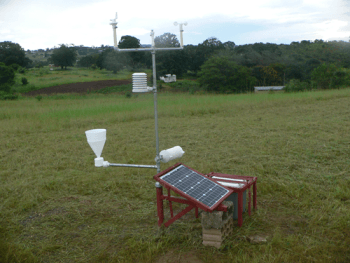Jun 3 2016
First cost-effective weather stations that are constructed mainly with 3D-printed components have been successfully installed by scientists. They are designed to deliver crucial data required for farmers and other people in developing countries.
 A newly installed weather station is at the Salvation Army's College of Biomedical Sciences in Chikankata, Zambia. The sensor on the left (with the funnel) is a specially designed tipping bucket rain gauge; the vertical, vented cylinder on the vertical arm of the station is a radiation shield containing temperature, humidity, and pressure sensors; and the horizontal cylinder protruding out the back contains a single-board computer. A wind vane (left), solar light sensor (middle), and three-cup wind anemometer (right) are mounted on the upper arm. The station is powered by a single solar panel and a backup battery. (credit: ©UCAR. Photo by Martin Steinson).
A newly installed weather station is at the Salvation Army's College of Biomedical Sciences in Chikankata, Zambia. The sensor on the left (with the funnel) is a specially designed tipping bucket rain gauge; the vertical, vented cylinder on the vertical arm of the station is a radiation shield containing temperature, humidity, and pressure sensors; and the horizontal cylinder protruding out the back contains a single-board computer. A wind vane (left), solar light sensor (middle), and three-cup wind anemometer (right) are mounted on the upper arm. The station is powered by a single solar panel and a backup battery. (credit: ©UCAR. Photo by Martin Steinson).
Weather experts at the National Center for Atmospheric Research (NCAR) and its managing entity, the University Corporation for Atmospheric Research (UCAR) created the weather stations. Easy replacement of the 3D-printed components when they were worn out during operation in the field is one of the key advantages of these stations.
The first five stations were installed in Zambia, and these are now transmitting data about weather parameters such as temperature, winds, and rainfall. This data and the ensuing forecasts can deliver weather data to local subsistence farmers to take decisions on plantation and fertilization of their crops. The data can also help in alerting communities about potential natural calamities such as floods.
It’s a major opportunity to provide weather information that farmers have never had before. This can literally make the difference when it comes to being able to feed their families.
Paul Kucera,NCAR scientist and one of the project leaders
The next step of the researchers is to explore the role these low-cost weather stations can play in other developing countries. The U.S. Agency for International Development's Office of Foreign Disaster Assistance and the U.S. National Weather Service are funding the project.
The bottom line is that 3D-printing will help to save lives. Not only can they provide countries with the ability to more accurately monitor for weather-related disasters, the data they produce can also help reduce the economic impact of disasters.
Sezin Tokar, a hydrometeorologist with U.S. AID
Like many other developing nations, Zambia lacks detailed forecasts due to scarcity of weather stations. The number of stations in Africa is eight folds lower than the recommended count by the World Meteorological Organization. Constructing a network is a costly affair considering the fact that $10,000 to $20,000 is typically required to build a single commercial weather station. One should also take into account the ongoing funding for routine maintenance and substituting worn-out components.
To address this issue, UCAR and NCAR researchers have spent several years to develop an economical and easily configurable weather station that can be customized to the requirements of the host nation. The ensuing weather stations are built out of custom-designed plastic components that can be fabricated using a printer, in combination with a basic, credit card-sized computer devised for schoolchildren and off-the-shelf sensors. The total cost of production is roughly $300 per station. Most importantly, replacement components can be easily printed by the host nation.
If you want a different kind of wind direction gauge or anemometer, or you just need to replace a broken part, you can just print it out yourself. Our role is to make this as accessible as possible. This is entirely conceived as an open-source project.
Project co-lead Martin Steinson of UCAR
Kucera and Steinson, in close cooperation with the Zambian Meteorological Department and other agencies, deployed the first weather stations earlier this year, with three close to radio stations that will transmit the data to local communities, one by the headquarters of the meteorological department, and one by a rural hospital.
The project will be taken over by the meteorological office later this year, with an objective of creating a network of 100 stations throughout Zambia. Materials, 3D printers, and training will also be provided as part of the effort to upgrade or maintain the network.
The weather station measurements can be accessed by local meteorologists and also sent over wireless networks to NCAR in real time. After installing all weather stations in Zambia, researchers will devise a system of one-to three-day regional forecasts for the country utilizing the NCAR-based Weather Research and Forecast (WRF) computer model.
Besides helping residents such as farmers, the country can use the forecasts to alert residents about the risk of impending weather-related disasters such as floods. The system will eventually be shifted to the Zambian Meteorological Department to perform the forecasts.
"The objective of the project is to transfer the technology so this will be run by Zambia," Kucera said.
After the installation of the weather stations in Zambia, Kucera and Steinson will extend the service to other countries that require additional weather stations, including in Africa or the Caribbean. Besides enhancing local forecasts, the observations acquired additionally can ultimately further improve forecasts worldwide as computer models universally will have additional atmospheric data.
We’re hearing a lot of interest in using this technology in other countries. It’s really quite a return on investment.
Sezin Tokar